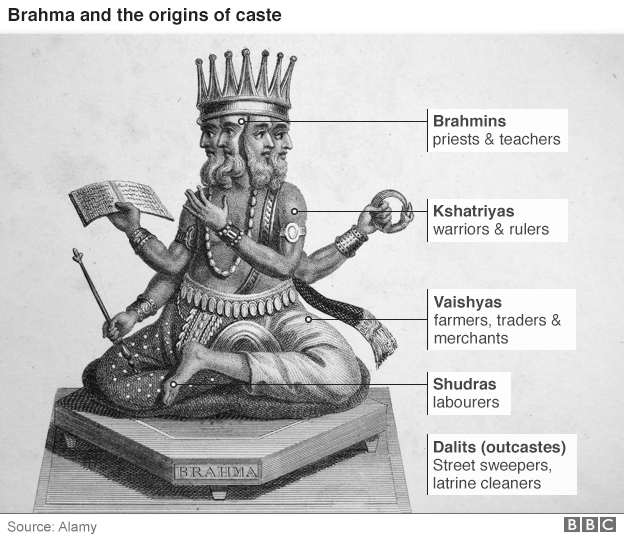Caste Discrimination (India): Educational Equity
By Aalia Choudhry and Sonia Schultes

What is caste discrimination in India?
The caste system in India is an example of separation based upon caste.This caste system originated in ancient India, though it has continued to be practiced in medieval, early modern, and modern India. This system consists of the Brahmins, the Kshatriyas, the Vaishyas, the Shudras, and the Dalits. The Brahmins were the priests and teachers of religion. The Kshatriyas were the warriors and rulers of India. The Vaishiyas were the farmers, traders, and merchants, while the Shudras were laborers. The Dalits were the outcasts, also known as the street sweepers.

Click here to get to know an organization that fights for Dalit children and their well-being.
How does caste discrimination relate to educational equity?
Though the Caste System in India was banned in 1948, it is still practiced in some parts of India. The Caste System also has a lasting impact on some communities. With this said, education equity may vary. To further explain, educational equity refers to the fair resources and access to education. Resources may include both material and no-material that a learning facility has access to the teaching-learning process. This includes material, such as student notebooks and material such as learning management systems. Access to education describes the availability to education. In India, the history of Caste System limits the amount of learning resources a lower class/community has, rather than an upper class school. We, therefore decided to focus our teaching on the educational equity discrimination in modern-day India.

Click here to find more about New York's education department and how it relates to discrimination and educational equity!
Connections
| Aalia's Connection |
Sonia's Connection |
| To connect with this idea of the caste system limiting the equity of education, we would like to compare this to our Chapin and other schools in New York City. In terms of equity based on caste, Chapin is a school for families who are very comfortable with finances. This means that in a sense, the school has a certain group of girls attending. To limit this idea that only people who can afford it can come to Chapin, there are resources to help people, such as financial aid. In terms of the resources we have, we are very fortunate to have so much technology and COVID-19 safety resources, such as equipment. This includes resources, such as our new Webex t.vs and cleaning resources. We have so many academic resources at Chapin, as well unlike the Dalits through the year in India, This should definitely change. |
My grandmother and grandfather were born and partly raised in India. Both were Kshatriyas, but they were farmers. The caste system seems to have not too much of an effect on them now, given that they were fine talking openly about it with me when I asked them. |
Statistics for Upper Class Children (Brahmins) Never Enrolled vs. College Graduate:
| Year |
Educational Status |
Percentage |
| 1983 |
Never Enrolled |
26.88% |
| 1988 |
Never Enrolled |
27.46% |
| 1994 |
Never Enrolled |
21.19% |
| 2000+ |
Never Enrolled |
17.08% |
| 1983 |
College Graduate |
8.91% |
| 1988 |
College Graduate |
9.48% |
| 1994 |
College Graduate |
12.46% |
| 2000+ |
College Graduate |
14.41% |
Statistics for Lower Class Children (Dalits) Never Enrolled vs. College Graduate:
| Year |
Educational Status |
Percentage |
| 1983 |
Never Enrolled |
53.30% |
| 1988 |
Never Enrolled |
53.36% |
| 1994 |
Never Enrolled |
46.15% |
| 2000+ |
Never Enrolled |
36.75% |
| 1983 |
College Graduate |
2.18% |
| 1988 |
College Graduate |
2.93% |
| 1994 |
College Graduate |
3.51% |
| 2000+ |
College Graduate |
4.83% |
Inspirational People: Mala Yousafzai

Click here to learn more about Malala Yousafzai's accomplishments.
- Who is she?
- She is a Pakistani activist.
- She spoke publicly about the prohibition of education for girls.
- She is the youngest Nobel Prize laureate.
- Fun Facts
- July 12th is World Malala Day.
- On October 9, 2012, she was shot for her activism.
- Connection to Caste System and Educational Equity
- Gender Stereotypes/groupings are similar to groupings by caste
- Educational disadvantage due to groupings in throughout history.
- Change from inspirational people to fight for educational equity.
- Quotes
- "I truly believe that the only way we can create global peace is through not only educating our minds, but our hearts and our souls."
- "If one man can destroy everything, why can't one girl change it?"
Sources:
Click here to see the resources we used to make this site!


